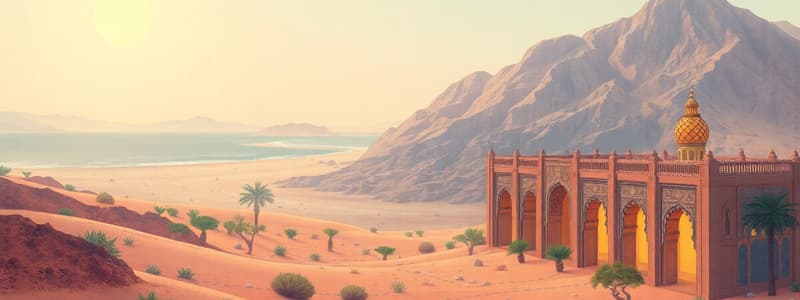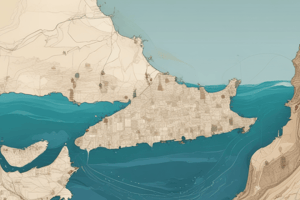Podcast
Questions and Answers
What percentage of the UAE does the desert environment cover?
What percentage of the UAE does the desert environment cover?
- 1/3
- 2/3 (correct)
- 1/2
- 3/4
Which of the following best describes the impact of oil discovery on Emirati society?
Which of the following best describes the impact of oil discovery on Emirati society?
- Population migration to rural areas
- Development of an industrial environment (correct)
- Increased reliance on traditional desert trades
- Reduction in maritime activities
Which city in the UAE is located at the end of the Arabian Gulf and is characterized by a central location?
Which city in the UAE is located at the end of the Arabian Gulf and is characterized by a central location?
- Fujairah
- Ajman
- Khor Fakkan (correct)
- Ras al Khaimah
What challenge did inhabitants face in the desert environment of the UAE before the oil era?
What challenge did inhabitants face in the desert environment of the UAE before the oil era?
Which of the following was a trade activity for inhabitants in the desert environment?
Which of the following was a trade activity for inhabitants in the desert environment?
What major event occurred in 2000 BC related to the Arabian Gulf?
What major event occurred in 2000 BC related to the Arabian Gulf?
Which explorer is noted for navigating ships across the Indian Ocean in the 15th century?
Which explorer is noted for navigating ships across the Indian Ocean in the 15th century?
What role did the East India Company play in the Arabian Gulf economy after British colonialism?
What role did the East India Company play in the Arabian Gulf economy after British colonialism?
During which caliphate did the Gulf become a major trade and navigation center?
During which caliphate did the Gulf become a major trade and navigation center?
What year marked the British occupation of Ras al-Khaimah?
What year marked the British occupation of Ras al-Khaimah?
Flashcards
UAE Regions
UAE Regions
The UAE is comprised of several regions, including Sharjah, Ras al Khaimah, Fujairah, Umm al Quwain, and Ajman, each with varying sizes and locations along the coasts (Arabian Gulf, Gulf of Oman).
Pre-Oil UAE Society
Pre-Oil UAE Society
Before oil discovery, Emirati society relied on desert and sea resources for sustenance.
Desert Environment (UAE)
Desert Environment (UAE)
Two-thirds of the UAE is desert; water scarcity impacted settlement and livelihoods. Traditional activities included grazing and trade.
Post-Oil UAE Environment
Post-Oil UAE Environment
Signup and view all the flashcards
UAE Coastal Regions
UAE Coastal Regions
Signup and view all the flashcards
Arabian Gulf trade in 1300s
Arabian Gulf trade in 1300s
Signup and view all the flashcards
Portuguese colonization impact
Portuguese colonization impact
Signup and view all the flashcards
British control of the Gulf
British control of the Gulf
Signup and view all the flashcards
British economic influence
British economic influence
Signup and view all the flashcards
British involvement in Gulf affairs
British involvement in Gulf affairs
Signup and view all the flashcards
Study Notes
Geography of the UAE
- Location: Arabian Gulf, bordering Qatar and Saudi Arabia to the west, Oman and the Gulf of Oman to the south.
- Coastline: 1,318 km
- Area: 77,700 km² without islands; 83,600 km² with islands. Third largest GCC country after Saudi Arabia and Oman.
- Geographical Features: Mostly desert land. Includes oases (Al-Ain, formed by water from Jebel Hafeet, distributed by aflaj); mountains (Jebel Hafeet and Jebel Hajar, reaching 80km, creating the Musandam Peninsula); coastal areas (mostly sandy, with the Musandam peninsula mountains); and gulf waters (average depth 35m, maximum 145m, 45°C hottest point in the world, rich in fish and pearls). Many islands (including Delma, Das, Um al-Nar, near Ras al-Khaimah, and also Tunb al Kobra, and al Soghra) are near the UAE coastline.
- Climate: Excessive heat and humidity in summer (April-September); Rainy season (October-March). Rain evaporation is 20 times the amount of rainfall.
- Oil Reserves: Abu Dhabi has most of the UAE's oil (92 billion barrels).
UAE Society and Culture
- Pre-Oil Society: Emirati society was associated with the desert and the sea.
- Post-Oil Society: Industrial environment developed.
- Environmental Impact (3 Environments):
- Desert: Limited resources (especially water) led to a nomadic lifestyle and trading of animal products.
- Sea: Reliable resources led to the development of navigation skills and trade with other lands.
- Effect on Trade: Materials from India (ropes, candles, wood) supported pearl diving and trade with other parts of Asia and Africa. Pearls were a key source of income (worth 8 million rupees in 1905).
- Diving Impact: Boosted the Emirati economy before oil discovery; significant impact on Emirati society.
- Worker Culture: Financial support for fishermen's families, roles of divers (shiyou), captains (nowkhadha), learners, and divers to contribute to the Emirati society.
UAE History
- Historical Roots: Civilizations from the Mesopotamian Valley and Iran influenced the region (c. 2000 BCE), which declined for unknown reasons, likely due to climate changes.
- Islam in the Gulf: Natives were familiarized with Islam and its concepts through pre-Islam trade relations and participations in the Hajj and trade travels before embracing the religion itself. The Prophet Mohammed sent emissaries to the Arab leaders inviting them to accept Islam. After accepting Islam, they liberated themselves from Persian Sassanids' oppression.
- Arabian Gulf After Islam: The Umayyad Caliphate made the Gulf a major trade center. Arab navigators (like Ahmed bin Majid) navigated the Indian Ocean, notably during the 15th century. The Portuguese later took control of the area in the 16th century, but weakened by internal European conflicts.
- British Influence: The British East India Company gained control over the Gulf in the 19th century. Arab tribes gained power in the 19th century; Bani Yas were dominant in the region leading to Abu Dhabi and Dubai founding.
UAE Political Development
- Projects & Experiments for Unification: Attempts to unite the Emirates begun in 1952, but were unsuccessful initially; it was made stronger and more successful when The efforts for unification continued during the 1960s-1970s.
- Abu Dhabi & Dubai Reciprocal Agreement: Agreement (2/18/1968) between Abu Dhabi and Dubai leaders to prepare for Emirati unification.
- Nonagon Union: An attempt (1968) to unite nine Emirates but failed.
- Seven-Emirate Union: Leaders in Abu Dhabi and Dubai focused on uniting seven emirates after the failed Nine-Emirate Union.
- Federation: The UAE was formally established in December 1971.
UAE Economic Development
- Macroeconomics: GDP measures a nation's economic output. This includes raw materials like oil, and services generated by the economic market.
- Pre-Oil Economy: Characterized by subsistence farming, fishing, and trade (e.g., pearls).
- Post-Oil Economy: Diversification (e.g., agriculture, fisheries, tourism) was pursued by the nation.
- Government Role: Establishing institutions, regulating the economy, creating policies, and using national resources (primarily oil) to further the economic growth.
- Non-Oil Policy: Diversification of income sources away from oil reliance, investment in industry supporting this goal.
UAE Education
- Pre-Federation Education: Semi-formal schools and education emphasizing religious study and trade were developed in the early 1900s. Education shifted in 1950s when merchants and parents paid for schools and teachers in support of educational development.
- Post-Federation Education: Rapid expansion of schools; Education became compulsory and the UAE modernized its educational methods and infrastructure (especially after the 1970s). Universities and colleges were established.
- Formal Education: Compulsory and free; curriculum development, and teacher training are focused on modern education systems.
- Higher Education: Universities including Emirates University and other institutions were established.
UAE Population and its Impact
- Imbalance: Significant population imbalance (males vs. females, young vs. old) existed due to immigration, and shifts in residence in the 1970s. This gap has closed somewhat due to policies that emphasized the population development in the UAE.
- Census Data (e.g., 1967, 1970, 1995): Data on population demographics (age, gender, origins) became more reliable over time to aid in long-term planning.
UAE Domestic Courts (Civil and Religious)
- Foreign Policy: The UAE establishes strong relationships with other nations through religious and economic ties.
- Gulf Circle: Relations focused on cooperation, common interests, and religious ties with other nations in the region.
- Arab League: Strong relations are maintained with the emphasis on cooperating, maintaining interests in accordance with the needs and interests of Arab nations, and providing financial assistance.
- Islamic Countries: UAE relations are based on mutual support, participation in projects, providing financial aid, and representation in international conferences.
- United Nations: The UAE is a member of the UN and actively participates in its global initiatives.
Studying That Suits You
Use AI to generate personalized quizzes and flashcards to suit your learning preferences.




